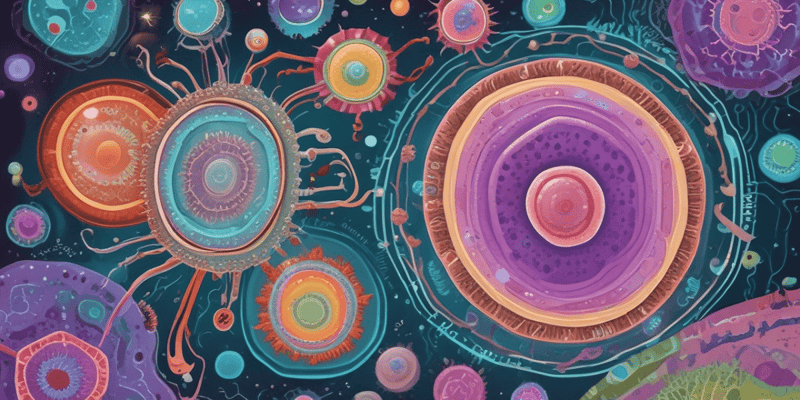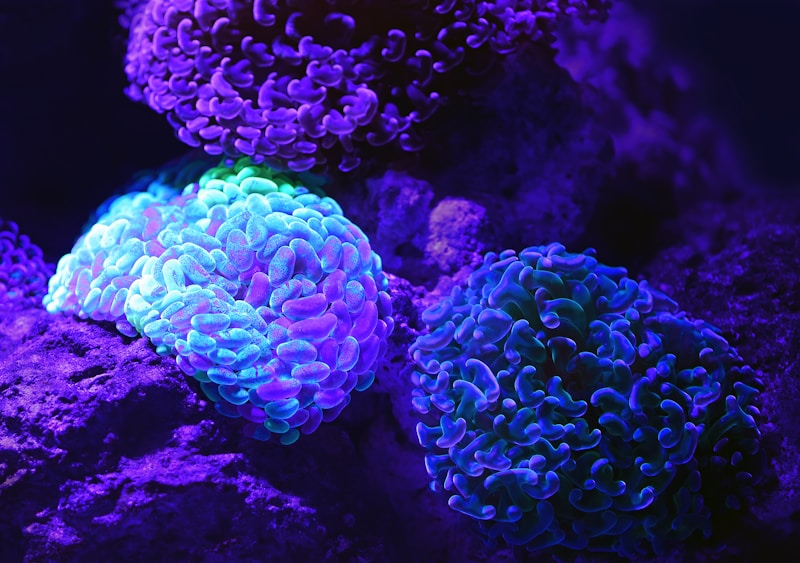Podcast Beta
Questions and Answers
What is a unique characteristic of prokaryotes that differentiates them from eukaryotes?
Which of the following describes how archaea differ from bacteria?
Which method do prokaryotes primarily use for reproduction?
What characteristic differentiates archaea from other prokaryotes?
Signup and view all the answers
What function do decomposer bacteria serve in ecosystems?
Signup and view all the answers
Which group of protists is primarily associated with photosynthesis and includes diatoms?
Signup and view all the answers
What type of bacteria have their peptidoglycan layer exposed to the external environment?
Signup and view all the answers
What is the main role of heterocysts in Anabaena?
Signup and view all the answers
Which organism is known for its symbiotic relationship with termites by breaking down cellulose?
Signup and view all the answers
Which of the following is NOT a primary shape of bacteria?
Signup and view all the answers
What is a defining feature of cyanobacteria that distinguishes them from heterotrophic bacteria?
Signup and view all the answers
How do autotrophic bacteria obtain energy?
Signup and view all the answers
Which of the following is a characteristic of stramenopiles?
Signup and view all the answers
What role do bacteria play in the microbiomes of many animals?
Signup and view all the answers
What type of environment do halophiles thrive in?
Signup and view all the answers
Which of the following statements regarding antibiotics is true?
Signup and view all the answers
What is the primary characteristic of the alveolates group?
Signup and view all the answers
What type of bacteria primarily serve as a source of biotechnology?
Signup and view all the answers
What distinguishes the vegetative cells in cyanobacteria?
Signup and view all the answers
Study Notes
Prokaryote Overview
- Prokaryotes are single-celled organisms without a nucleus or membrane-bound organelles.
- They have circular, single DNA and reproduce asexually through binary fission.
- They are microscopic and have cell walls.
- Prokaryotes are found in two domains: Bacteria and Archaea.
Bacteria
- Bacteria can be heterotrophs, gaining energy by consuming organic molecules, or autotrophs, using light or chemical energy to produce organic molecules.
- Heterotrophic bacteria are often decomposers, breaking down organic matter.
- Bacteria can have three main shapes: bacilli (rod-shaped), cocci (spherical), and spirilli (spiral-shaped).
- Bacteria are beneficial to humans in many ways: they act as decomposers, ferment foods, are used in biotechnology, compose microbiomes, and fix nitrogen.
- Antibiotics can be used to kill bacteria by disrupting the peptidoglycan cell wall.
Bacterial Cell Walls
- Two types of cell walls: Gram-positive (peptidoglycan exposed) and Gram-negative (peptidoglycan protected by an outer membrane).
- Antibiotic resistance is a growing concern, as bacteria adapt to decrease the effectiveness of antibiotics.
Exposure Plate Analysis
- Exposure plates are used to analyze the growth of microorganisms.
- Three types of growth patterns can be observed:
- Mold: fuzzy with different rings of color
- Yeast: smooth or wrinkled with lighter colors
- Bacteria: small, smooth, domed with various colors
Cyanobacteria
- Cyanobacteria are a group of autotrophic bacteria that photosynthesize using pigments like chlorophyll and phycocyanin.
- They are larger than heterotrophic bacteria and form long filaments of many cells.
- They are surrounded by a gelatinous layer that provides motility and makes them slimy.
- Cyanobacteria can both photosynthesize and fix nitrogen.
- Two examples studied are Oscillatoria and Anabaena.
- Oscillatoria: lack heterocysts and fix nitrogen when oxygen levels are low (temporal separation).
- Anabaena: have both heterocysts and vegetative cells.
Archaea
- Archaea resemble early forms of life and are often found in extreme environments (extremophiles).
- Different types of archaea are classified based on their preferred environment:
- Thermophiles: extremely hot environments
- Psychrophiles: extremely cold environments
- Acidophiles: acidic environments
- Alkaliphiles: alkaline environments
- Halophiles: salty environments
- Methanogens: anaerobic environments, releasing methane.
- Archaea have cell walls that do not contain peptidoglycan, and their cell membranes have a different composition than phospholipid bilayers in prokaryotes and eukaryotes.
- So far, archaea have not been found to be pathogenic.
Protist Overview
- Protists are eukaryotic organisms that are not plants, animals, or fungi.
- They are diverse and divided into four groups: Excavata, SAR, Archaeplastida, and Unikonta.
Excavata
- Excavates are characterized by grooves on one side, multiflagellated structures, and are often found in anaerobic environments.
- They have reduced mitochondria, and exhibit diverse lifestyles: parasitic, predatory, and photosynthetic.
- Examples include Trichonympha and Euglena.
SAR
- SAR includes a wide variety of protists with diverse characteristics, including:
- Stramenophiles: photosynthetic with hairy and smooth flagella. Examples include diatoms, golden algae, and brown algae.
- Alveolates: have membranous sacs near their plasma membrane. Examples include dinoflagellates, Plasmodium vivax, and Paramecium.
- Rhizarians: have long, thin pseudopodia and porous shells. Examples include radiolarians and forams.
Archaeplastida
- Archaeplastida are photosynthetic protists that contain plastids, which originated from endosymbiosis.
- They are diverse in color and size, with examples including red algae (rhodophytes) and green algae (chlorophytes).
Spirogyra
- Spirogyra is a filamentous green algae species with spiral-shaped chloroplasts.
- Its spiral arrangement helps maximize light collection.
- Its plastids, size, and nucleus distinguish it from other cyanobacteria.
Unikonta
- Unikonta include both animals and fungi.
- This group is further divided into amoebozoans and opisthokonts.
- Amoebozoans: possess large, wide pseudopodia.
- Opisthokonts: synthesize extracellular chitin, cysts/spore walls, or cell walls.
Amoeba
- Amoebas have a nucleus, pseudopods, and a cell membrane.
- They move in the direction of their pseudopods to find food.
- They consume bacteria, algae, and other protozoa.
Studying That Suits You
Use AI to generate personalized quizzes and flashcards to suit your learning preferences.
Related Documents
Description
This quiz covers key concepts about prokaryotes, including their classification, structure, and reproduction. Dive into the role of bacteria in ecosystems, their different shapes, and their significance in human life. Test your understanding of bacterial cell walls and their importance in microbiology.




